From the day we brought her home at 10 weeks old, my Rough Collie puppy, Dashi, was obsessed with flirt poles, toys on long strings or ropes, and anything she could chase or pounce on. As a herding dog, she’s extremely attracted to movement, and anything quick-moving triggers her instinctual herding and chasing drive.
Fast CAT–short for fast coursing ability test–can be an excellent activity for dogs like Dashi who love the act of chasing, and it’s an extremely beginner-friendly dog sport that doesn’t require much training. If your pup is obsessed with the flirt pole or just needs an appropriate outlet for their prey drive, look into trying AKC Fast CAT.
What is Fast CAT?
At its core, Fast CAT is a type of lure coursing sport. During Fast CAT tests, dogs run a timed 100-meter dash chasing a lure (a plastic bag or other piece of plastic) on a moving line down a fenced-in course. Dogs are released by one person at the beginning of the course and caught at the end of the course by another. They accumulate points towards titles based on a formula that takes into account the dog’s height and speed, and even get ranked against other dogs in their breed.
How to Get Started in AKC Fast CAT
Fast CAT has the fewest barriers to entry of almost any dog sport. As an instinct-based sport, many dogs who like to chase will be able to enter an event and start accumulating points and titles with little to no practice. There are just a few rules all participants must follow:
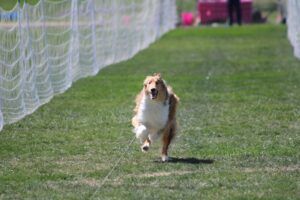
- Your dog must have an AKC registration number, or if your dog is a mixed-breed, an AKC PAL number.
- Your dog must be over 12 months of age to do an official run. Some clubs will allow puppy bumps (a shortened course length) or fun runs for younger dogs, but these don’t count towards title points.
- Your dog must be physically sound. Fast CAT organizers will have you trot your dog down and back when you check into a test to make sure your dog isn’t limping and is moving normally.
- If you have an intact female, she can’t be in heat at the time of the run. Fast CAT organizers will ask you to do a “tissue test” wipe when checking in to make sure your bitch isn’t in season.
How to Find and Enter Fast CAT Events
The easiest way to find Fast CAT tests near you is to use the AKC Event Search tool. Once you’re on the event search page, just click on “performance events”, then select Fast CAT. You can then filter upcoming events by date, state, and more criteria. Once you’ve found an event you’re interested in, click on “View Complete Event Details,” and you’ll get information like the host club’s website, the event chair, the Fast CAT contact person, and more.
AKC’s Event Search doesn’t always give you a direct link to enter Fast CAT tests. You’ll sometimes need to do some extra digging to find the actual event through a club website, or you may need to email the contact person listed for more information. In addition to AKC Event Search, joining Facebook groups related to dog sports can be a good way to find out about upcoming Fast CAT tests. Fast CAT is often held in conjunction with all-breed dog shows too, so check out the premium lists of any upcoming dog shows in your area to see if Fast CAT will be offered.
Many Fast CAT organizers offer discounted pre-entry if you register for runs ahead of time. In terms of cost, fun runs or puppy bumps are usually around $10, and pre-registration for real runs can run between $20-$35 per run depending on the area and the lure operator. Day-of registration is sometimes available too but is often more expensive than the pre-registration cost.
Tips for Your First Fast CAT Event
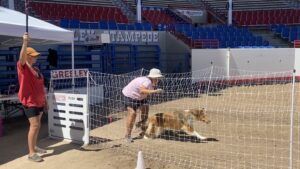
If you know someone who can release your dog for you at the start line, ask them to come along! Oftentimes, it’s recommended that the dog’s owner be the one to catch them at the end of a Fast CAT run, so they sprint fast to get to you. Event staff usually have an extra person on hand to help release dogs, but if your dog isn’t comfortable with strangers handling them, it may be less stressful to have someone they know release them.
The Fast CAT environment can be overstimulating for some dogs. Many dogs bark and get over excited when they see the lure, so it’s best to wait for your dog’s turn away from the actual course. It’s a good idea to bring a crate and some kind of crate cover so you can give your dog some space away from the commotion.
Lastly, make sure to warm your dog up before her run! You wouldn’t want to do a 100-meter dash right after waking up from a nap, so walk your dog around, jog a bit, or do some canine conditioning exercises to get her ready to run her fastest.
How to Calculate Fast CAT Points
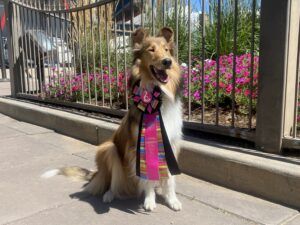
Once your dog has run her first Fast CAT dash, you’ll probably want to see how fast she ran and how many points she earned. To get the miles per hour calculation, divide 204.54 by your dog’s run time. To calculate points, multiply that number by your dog’s handicap. Handicap depends on height and is intended to even the playing field for dogs of all sizes. For dogs under 12” at the withers, the handicap is 2, for dogs between 12” and 18”, the handicap is 1.5. Sorry large dogs, any dog over 18” at the shoulder has a handicap of 1, meaning their score won’t change due to their height.
For example, my Collie’s most recent run time was 9.72 seconds. When I divide 204.54 by 9.74, I get 21.04, which is her MPH. She’s over 18” at the shoulder, so I’ll multiply that by 1, which leaves me with the same number. That means she earned 21.04 points for her 9.72 second run.
Once your dog starts accumulating points, you can aim to start collecting titles (which often come with fun ribbons and rosettes). Here’s the lineup of Fast CAT titles and the respective points needed to achieve them:
- BCAT: 150 points
- DCAT: 500 points
- FCAT: 1000 points
FCAT2, FCAT 3, etc: Dogs can gain additional FCAT levels with every additional 500 points earned




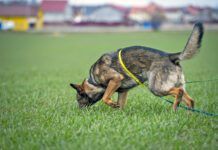
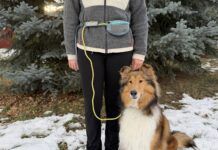

It’s 100 yards for the distance they run, not 100 meters.